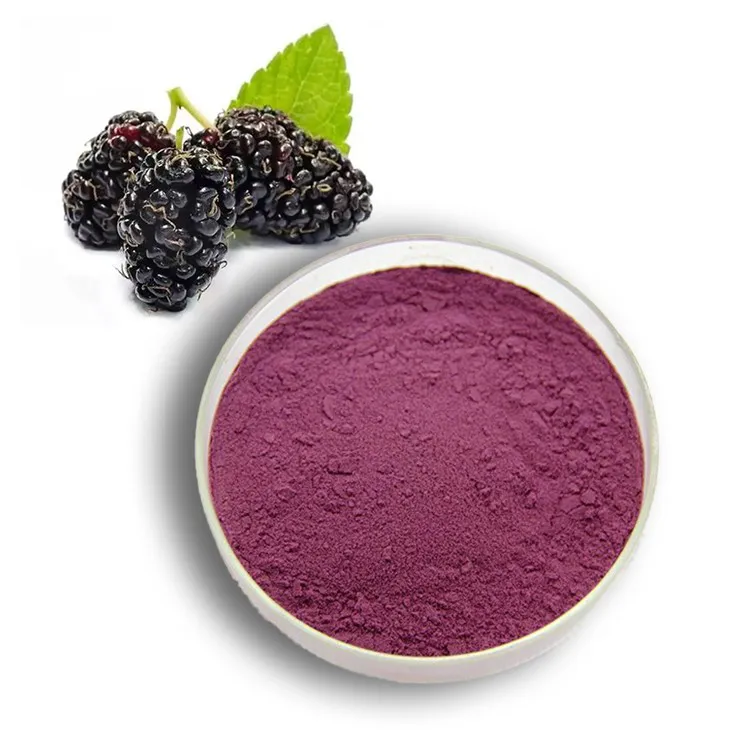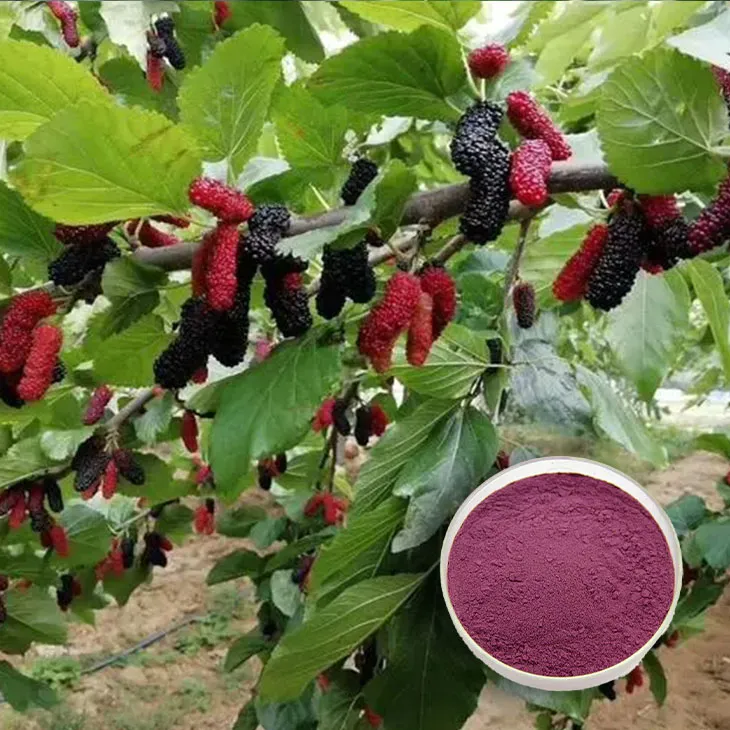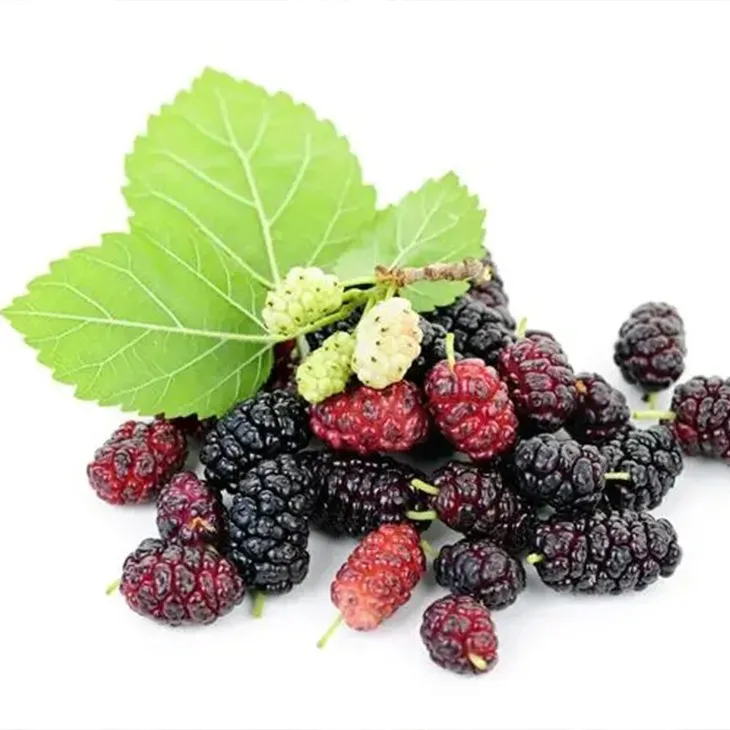- 0086-571-85302990
- sales@greenskybio.com
Mulberry Extract: Uses, Advantages, and Manufacturing Processes
2024-11-13

1. Introduction
The mulberry, a plant with a long history of use in various cultures, has been increasingly recognized for the value of its extract. Mulberry Extract, also known as Sang - shen extract in some traditional medicine systems, offers a wide range of potential applications. This article will explore its uses, advantages, and manufacturing processes in detail.

2. Uses of Mulberry Extract
2.1 In the Food Industry
Mulberry Extract has found significant use in the food industry. Rich in color, it serves as an excellent natural colorant. The deep purple or black hues of mulberries can add an appealing visual aspect to food products. For example, it can be used in the coloring of beverages, such as juices and soft drinks, giving them a more natural and attractive appearance compared to synthetic colorants.
Furthermore, mulberry extract functions as a flavor enhancer. It imparts a unique, slightly sweet and fruity flavor to foods. This makes it a desirable ingredient in confectionery items like candies, jellies, and ice creams. In addition, it can be added to baked goods, such as cakes and muffins, to enhance their overall flavor profile.
2.2 In the Pharmaceutical Field
There is growing interest in the pharmaceutical potential of mulberry extract. One of the most studied areas is its role in treating diabetes. Some research suggests that certain compounds in mulberry extract may help in regulating blood sugar levels. This could be a significant development in the search for natural alternatives to manage diabetes, which is a global health concern.
Mulberry extract may also possess other health - promoting properties. It has been investigated for its antioxidant effects. Antioxidants are important in neutralizing free radicals in the body, which are associated with various diseases and the aging process. Additionally, there is some evidence to suggest that mulberry extract could have anti - inflammatory properties, although more research is needed to fully understand these potential benefits.
2.3 In Cosmetics
The beauty industry has also embraced mulberry extract. Due to its antioxidant properties, it can be used in skincare products. It may help in protecting the skin from damage caused by environmental factors such as UV radiation and pollution. In skin creams and lotions, mulberry extract can potentially slow down the aging process by reducing the formation of wrinkles and improving skin elasticity.
Mulberry extract is also used in haircare products. It may help in promoting healthy hair growth and improving the overall condition of the hair. For example, it could be included in shampoos and conditioners to strengthen the hair shaft and add shine.

3. Advantages of Mulberry Extract
3.1 Versatility
One of the main advantages of mulberry extract is its versatility. It can be incorporated into a diverse range of products. As mentioned earlier, it is suitable for use in the food, pharmaceutical, and cosmetics industries. This wide applicability makes it a valuable ingredient for manufacturers looking to develop new and innovative products.
In the dietary supplement market, mulberry extract can be formulated into capsules, tablets, or powders. It can be combined with other nutrients and herbal extracts to create products that target specific health concerns, such as blood sugar management or antioxidant support. In cosmetics, it can be blended with different types of oils, emulsifiers, and other active ingredients to produce effective skincare and haircare products.
3.2 Sustainability
Mulberries are relatively easy to cultivate, which contributes to the sustainability of mulberry extract production. They can grow in a variety of climates and soil conditions, although they thrive best in warm and sunny environments. Mulberry trees are also relatively low - maintenance, requiring minimal pesticide and fertilizer use in many cases.
The ability to cultivate mulberries on a large scale without excessive environmental impact makes mulberry extract an attractive option for industries that are increasingly focused on sustainability. This is especially important in the current context where consumers are more conscious about the environmental footprint of the products they use.
3.3 Natural and Safe
Being a natural extract, mulberry extract is generally considered safe for use in various applications. In the food industry, it provides a natural alternative to synthetic additives, which may be associated with potential health risks. In cosmetics and pharmaceuticals, its natural origin is often seen as a positive attribute, as it may be better tolerated by the body compared to some synthetic chemicals.
However, it is important to note that, like any substance, proper safety evaluations and quality control measures should be in place. Although mulberry extract has a long history of traditional use, scientific research is still ongoing to fully understand its safety profile, especially in high - dose or long - term use scenarios.

4. Manufacturing Processes of Mulberry Extract
4.1 Traditional Extraction Methods
After the mulberries are harvested, the first step in the extraction process is usually to crush the berries. This helps to break down the cellular structure and release the active compounds. Once crushed, the mulberries can be subjected to solvent extraction.
Solvent extraction involves using a suitable solvent, such as ethanol or water, to dissolve the active compounds from the mulberry pulp. Ethanol is often preferred in the pharmaceutical and cosmetics industries due to its ability to extract a wide range of compounds and its relatively low toxicity. Water extraction, on the other hand, is more commonly used in the food industry as it is a more natural and safe option for food - grade products.
After the extraction with the solvent, the resulting solution is usually filtered to remove any solid particles. The filtrate, which contains the mulberry extract, is then concentrated. This can be done through evaporation, where the solvent is removed under controlled conditions, leaving behind a more concentrated extract.
4.2 Modern Extraction Techniques
In recent years, modern techniques such as supercritical fluid extraction have been explored for mulberry extract production. Supercritical fluid extraction uses a supercritical fluid, typically carbon dioxide (CO₂), as the extracting agent. CO₂ in its supercritical state has unique properties that make it an excellent solvent for extracting active compounds from mulberries.
The main advantage of supercritical fluid extraction is its ability to produce a more pure and effective extract. It can selectively extract specific compounds while leaving behind unwanted substances. This results in a higher - quality extract with a more consistent composition. Additionally, since CO₂ is a gas at normal conditions, it can be easily removed from the extract, leaving no residue, which is important for applications in the food, pharmaceutical, and cosmetics industries.
Another modern technique being investigated is ultrasonic - assisted extraction. This method uses ultrasonic waves to enhance the extraction process. The ultrasonic waves create cavitation bubbles in the solvent, which help to break down the cell walls of the mulberries more effectively, increasing the release of active compounds. This technique has the potential to reduce extraction time and improve extraction efficiency compared to traditional methods.
5. Conclusion
Mulberry extract offers a wide range of uses, from being a natural colorant and flavor enhancer in the food industry to having potential health - promoting properties in the pharmaceutical field and cosmetic applications. Its advantages, such as versatility, sustainability, and being natural and safe, make it an appealing ingredient for various industries.
The manufacturing processes of mulberry extract, both traditional and modern, are constantly evolving to improve the quality and efficiency of extraction. As research continues, it is expected that more will be discovered about the full potential of mulberry extract, leading to even more innovative applications in the future.
FAQ:
What are the main uses of Mulberry Extract in the food industry?
It can be used as a natural colorant and flavor enhancer in the food industry because of its rich color and unique flavor.
Why is Mulberry Extract considered in the treatment of diabetes?
It is being studied for its potential in treating diabetes as it may help regulate blood sugar levels.
What makes Mulberry Extract versatile?
It can be incorporated into various products, ranging from dietary supplements to cosmetics, which makes it versatile.
Why is Mulberry Extract considered sustainable?
It is sustainable because mulberries are relatively easy to cultivate.
What are the general steps in the production process of Mulberry Extract?
After harvesting the mulberries, they are crushed and then subjected to extraction methods. Modern techniques like supercritical fluid extraction are also being explored to obtain a more pure and effective extract.
Related literature
- Mulberry Extract: A Comprehensive Review of Its Phytochemical Composition and Therapeutic Potential"
- "The Role of Mulberry Extract in the Food and Pharmaceutical Industries: Current Research and Future Perspectives"
- "Manufacturing High - Quality Mulberry Extract: Best Practices and Emerging Technologies"
- ▶ Hesperidin
- ▶ Citrus Bioflavonoids
- ▶ Plant Extract
- ▶ lycopene
- ▶ Diosmin
- ▶ Grape seed extract
- ▶ Sea buckthorn Juice Powder
- ▶ Fruit Juice Powder
- ▶ Hops Extract
- ▶ Artichoke Extract
- ▶ Mushroom extract
- ▶ Astaxanthin
- ▶ Green Tea Extract
- ▶ Curcumin
- ▶ Horse Chestnut Extract
- ▶ Other Product
- ▶ Boswellia Serrata Extract
- ▶ Resveratrol
- ▶ Marigold Extract
- ▶ Grape Leaf Extract
- ▶ New Product
- ▶ Aminolevulinic acid
- ▶ Cranberry Extract
- ▶ Red Yeast Rice
- ▶ Red Wine Extract
-
Curcuma Longa Extract/Turmeric extract
2024-11-13
-
Giant Knotweed Extract
2024-11-13
-
Ivy Extract
2024-11-13
-
Hawthorn Extract
2024-11-13
-
melatonin extract
2024-11-13
-
Troxerutin
2024-11-13
-
Aminolevulinic acid
2024-11-13
-
Almond Extract Powder
2024-11-13
-
Lemon Balm Extract
2024-11-13
-
Centella Asiatica Extract
2024-11-13





















